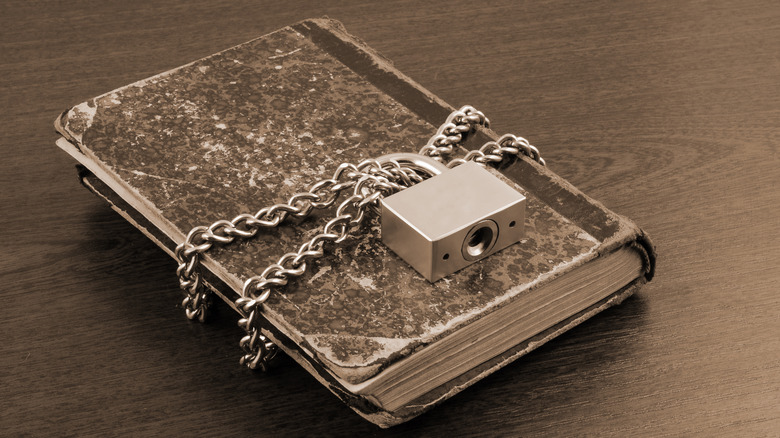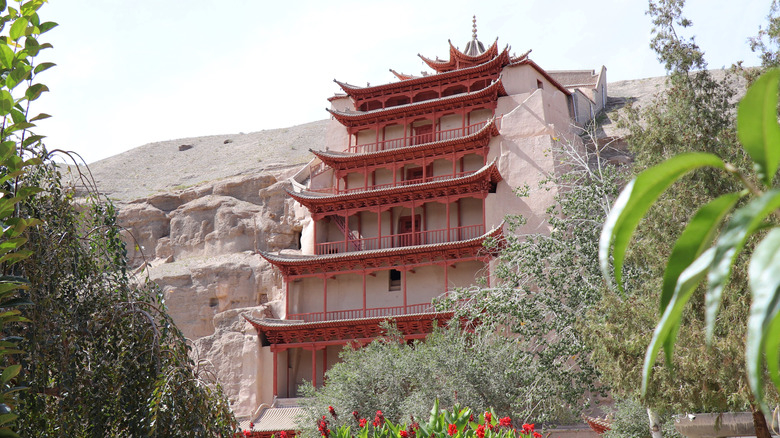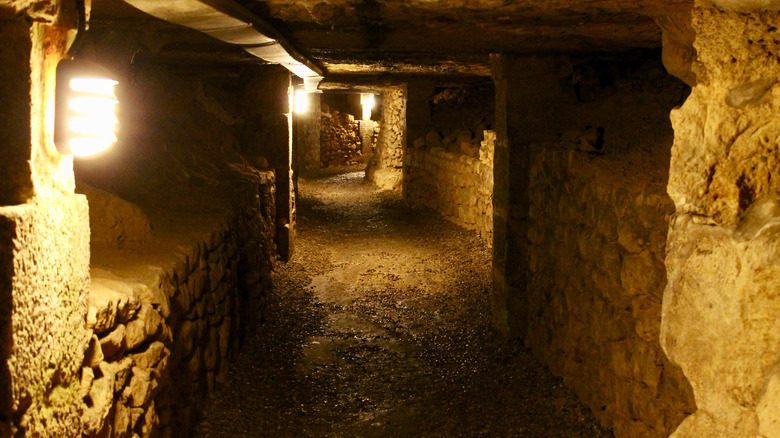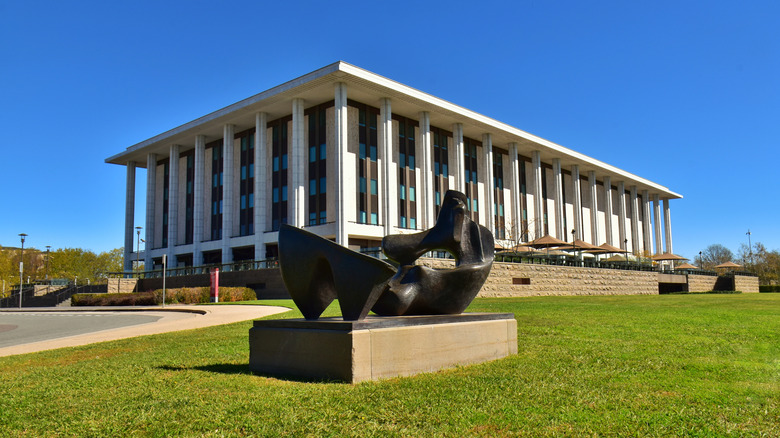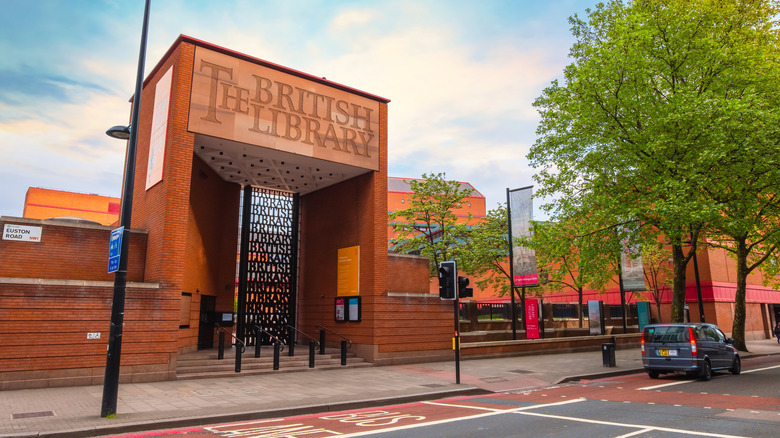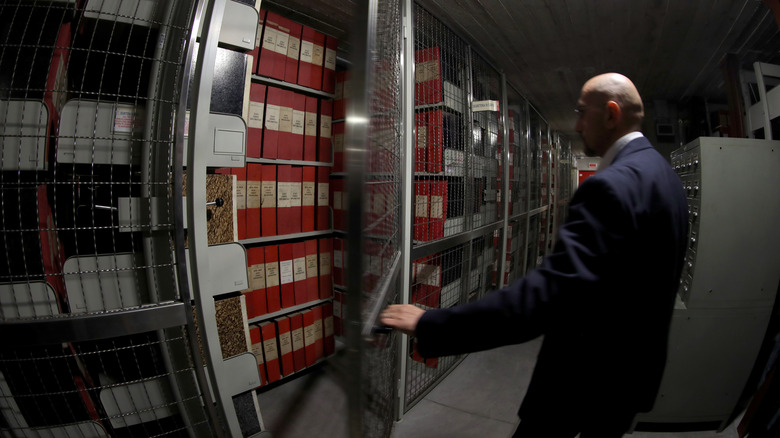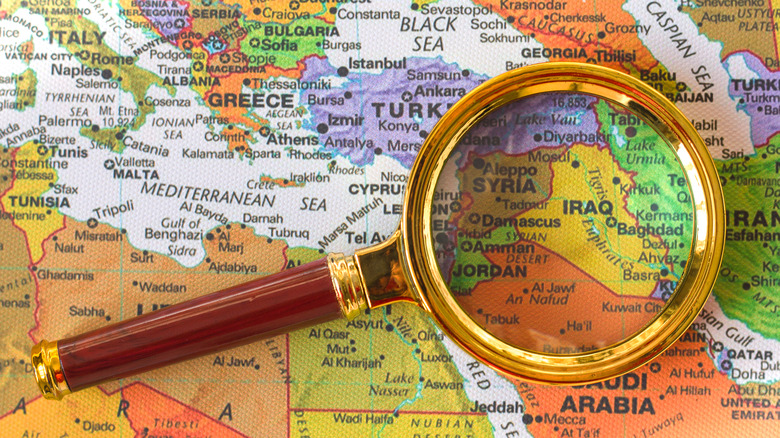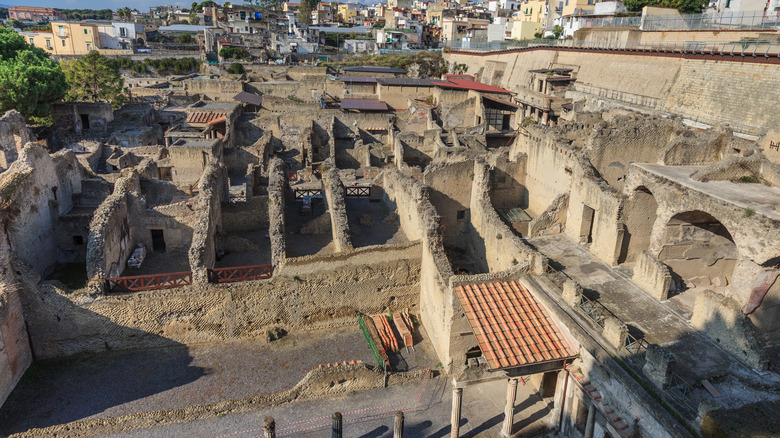Secret Libraries Around The World
Humankind has had a desire to record and share knowledge for a long time. According to the British Library, the written word was developed in multiple regions completely independently of each other, starting with Mesopotamia. They were writing things down about 5,500 years ago, using first pictures and then characters to represent the sounds of their language.
Similar systems also developed thousands of years ago in China, Egypt, and Mesoamerica, which is pretty wild stuff. While it took a while for people to write enough books to make libraries worthwhile, those happened surprisingly early, too: History says that the world's oldest library was founded in Nineveh — modern-day Iraq — in the seventh century B.C. It was protected by the power of curses inscribed on tablets, and needless to say, those didn't really work all that well. The tablets were still plundered — and unsurprisingly, some can be seen at the British Museum — but there are some libraries that have managed to hold onto their secrets.
Whether they're accessible only to a small group of people, have collections that are kept behind lock and key, or have even been completely lost for centuries, there are still a handful of truly secret vaults of knowledge still left in the world. So, let's talk about libraries not many people — if any — will ever get to see.
The Library Cave, China
The so-called Library Cave is a treasure trove of about 50,000 historical, religious, and political documents spanning — mostly — the ninth and 10th centuries. It was a secret for centuries more — not necessarily because anyone wanted to keep the knowledge off-limits, but because it was sealed up and forgotten about.
The cave, says Getty, was just one of around 500 that were carved by hand out of the cliffs between the city of Dunhuang and the Gobi Desert. The work was done between the fourth and 14th centuries, and fortunately, inscriptions found in the Library Cave — or Cave 17 — give some specifics on the ancient library.
Learn Religions says that the library was originally under the care of a Buddhist monk named Hongbian. He died in 862, but the collection continued to grow: And here's where things get a little fuzzy. Many of the documents are dated, and the latest discovered so far is from 1002. It's thought that marks a give-or-take kind of date as to when the cave was sealed and forgotten about, until it was rediscovered about 900 years later. It wasn't until 1890 that Wang Yuanlu, a Daoist monk, rediscovered the caves and took it upon himself to become the new caretaker. He unsealed the Library Cave in 1900, and it was a monumental find. Manuscripts included everything from medical texts to descriptions of games and dance, along with the world's oldest printed book, a copy of the Diamond Sutra from 868.
The Future Library, Norway
The exact contents of the Future Library are secret because, well, it hasn't been printed yet. Technically. It's the wildly cool brainchild of a Scottish artist named Katie Paterson, and here's the gist (via The Guardian). In 2014, Paterson and her team planted 1,000 trees in Norway. Those trees will grow until 2114, when they'll be cut down and turned into paper that will then be used to print the books of the Future Library.
What books are these? Every year, one author will submit a piece of work to be published as part of the library in 2114. The first year was Margaret Atwood, who had this to say about writing a story that won't be read until after most people currently on the earth are gone: "You don't know who they will be, you don't know their age, or gender, or nationality, or anything else about them. So books, anyway, really are like the message in the bottle."
So far, other authors asked to create something (with the only guideline being it should have something to do with time and imagination) include David Mitchel, Sjón, Elif Shafak, Han Kang, Karl Ove Knausgård, and Ocean Vuong, all of whom have submitted works that will go unread for nearly a century. In the meantime, they're going to be kept in Oslo's Deichmanske public library, but this section? It's anything but public.
La Librairie, France
Paris might be the city of lights, romance, and croissants, but underneath this most elegant of European cities, it's a completely different story. The Smithsonian calls the 200+ miles of tunnels an "Empire of Death," and that's eerily accurate.
In 1780, a problem that the city knew it had was suddenly spilling out onto the city streets in a quite literal way that made it impossible for people to keep looking the other way. Les Innocents cemetery had literally overflowed and dumped a whole lot of dead bodies into nearby properties, so the answer was to move many of the dead into the miles and miles of underground tunnels.
Those tunnels are still there, and they're not for the faint of heart. When LitHub's Will Hunt went on a guided (and not-entirely-legal) tour of the tunnels, it involved some serious spelunking-style exploration. Squeezing through maze-like tunnels — some so small they require the bravest to squeeze through on their stomachs — is punctuated by open rooms transformed into everything from art galleries to dance floors and even a movie theater. And in there as well? A very small library, where anyone who stumbles across it might find a book or two to take alone. It's called La Librairie, and although the damp, underground air isn't kind to any books left there for a long period of time, the hand-carved shelves are one more reminder of the cataphiles who came before. If, that is, you can find it.
Ivan the Terrible's lost library, Russia
In 1925, The New York Times reported that there was something big going on in Moscow: The Soviets were mounting an excavation of the Kremlin, in the hopes of finding Ivan the Terrible's library. They didn't find it — but if they had, it would have been one of the biggest finds in archaeological history.
According to the story (via BookRiot), the library was started by Ivan the Terrible's grandfather, Ivan III, or Ivan the Great. In addition to books from far-flung places like Egypt, Rome, and China, Ivan III's second wife, Sophia Palaiologina, brought more priceless books into the marriage with her. The collection then passed to Ivan the Terrible, and when he died in 1584, he took the secrets of his library with him.
People have been looking for the library for centuries, but it's never been found. It's so elusive, in fact, that some suggest it doesn't even exist anymore — and perhaps, it never did in the first place. There are some compelling pieces of evidence that say otherwise, including a mention in the biography of Maximus the Greek. He wrote that Ivan the Terrible's father had a shockingly impressive collection of Greek manuscripts, and it's entirely possible they were discovered in 1724. That's when officers at the Kremlin stumbled across a secret passage containing trunks full of books, which was promptly sealed and made off-limits by then-regent Sophia. Is it still there, deep beneath the Kremlin? Who knows!
The National Library of Australia's giftschranks, Australia
The National Library of Australia has tons of fascinating things in their vast collections, and as ABC News points out, visitors can find an almost seemingly infinite amount of information there. But there's one section that's not just off-limits, but it's kept in a locked room called a giftschrank. It's a German word that combines "poison" and "cabinet," and it's so secret, those who aren't in-the-know have no clue where it's even located.
Alison Dellit is the director of Australian Collections Management, and she has said just what the collection contains — and some of it actually is dangerous. In the collection are, for example, copies of textbooks that were printed with potentially deadly mistakes. She explained: "We do have material in here that accidentally recommended toxic combinations of chemicals be used, for example."
That's not all that's being kept under lock and key, either. The collection also includes things like how-to guides for euthanasia, and books legally determined to be defamatory. Individual branches of the library also have their own giftschrank rooms, although these are less tightly controlled and access can be given to those with good reason to be looking through the materials there. What sort of books are these? It's materials like family histories, and surprisingly? They also have a massive collection of materials related to magicians and their tricks — which is also not on public display.
The British Library's Private Case, England
Let's start with the elephant in the room here: This collection is no longer secret or restricted, and in fact, The Guardian says that it's been digitized and put online. It's worth a mention, though, because for centuries, the British Library kept the parts of their collection deemed unsuitable for public consumption hidden far away from prying eyes. It was called the Private Case, and it was essentially a set of locked cupboards in a back room. Set up in the 1850s, it once held works that dated back two centuries prior. The vast majority of what was relegated to the Private Case were X-rated books, or those with what the British Library calls "saucy engraved illustrations."
But delicate Victorian-era sensibilities aside, it's a fascinating glimpse into a less prude side of history. They've got things like copies of "Fanny Hill or Memoirs of a Woman of Pleasure," which is thought to be the first English-language book that would get itself an XXX rating. There's also editions of the 18th-century guide to sex workers, called "Harris's Lists of Covent-Garden Ladies," along with some erotica now believed to have been written by Oscar Wilde.
What was deemed scandalous enough to be secreted away in the depths of the library's Private Case varied throughout the years, and at one time, it held around 4,000 volumes. It's not so secret anymore, but it's worth remembering what was — until a few decades ago — once deemed wildly inappropriate.
The Vatican Apostolic Archives
Up until 2019, the 53 miles of underground shelves and vaults that were off-limits to pretty much everyone were called the Vatican Secret Archives — until, says The Guardian, Pope Francis decreed they were going to be called the Vatican Apostolic Archives. The idea was to get rid of any implication that there was something shady going on there, and did it work? That's up for debate, but there's kind of good news for anyone who's interested in what's actually being kept down there. It's being opened bit by bit, but there's a massive catch — it's open to "qualified researchers." For the vast majority of the public, it's still off-limits.
And that's a shame, because The Atlantic says there's some juicy stuff in there — and in 2020, they "opened" the section of documents that dealt with the reign of Pius XII, who was pope during World War II. Did the world want to know all about the Vatican's dealings with Nazi Germany and fascist Italy? Absolutely.
According to History, access to the archives is a little complicated. Even though it was late 19th-century pope Leo XIII who theoretically opened the whole thing to researchers, anyone who wants to go in still has to go through a complicated vetting process. Once they're there, there's not even a guarantee they'll find what they're looking for: In 2005, archive prefect Sergio Pagano admitted that it's not necessarily a matter of keeping secrets, but of knowing what's there and where the heck it is.
Darayya's secret library, Syria
Above-ground, the Syrian suburb of Darayya — just outside of Damascus — is a war zone. Streets are an obstacle course of bullets and debris, but beneath a building that was destroyed by bombs long ago is something that one frequent visitor described (via The New York Times) as an "oasis of normality in this sea of destruction."
It is, of course, a library, filled with books that devoted collectors have rescued from the remains of homes and other buildings. Originally overseen by a teenage librarian, the location needed to remain secret for a terrifying reason: If they were discovered, they would become a priority target for the Syrian Army. For those remaining in what's left of Darayya, it's more than just a library: It's a place where people can go to find the resources they need to survive. Would-be dentists and doctors teach themselves how to treat patients while amateur teachers read ahead of their students to learn what they're supposed to be teaching.
According to the BBC, some residents find it's too dangerous to actually visit the library. But for those who do, it's invaluable. When asked if books are more important than food, Abdulbaset Alahmar explained: "I believe the brain is like a muscle. And reading has definitely made mine stronger. My enlightened brain has now fed my soul, too. In a sense, the library gave me back my life ... I would say that just like the body needs food, the soul needs books."
Oxford's Bodleian Libraries, England
First, a disclaimer: The Bodleian Library's Phi Collection is still around, but new books are no longer being added, and as for those that are already in the X-rated collection? Even they're not as secret as they once were — and it was no joke. According to the head of the Bodleian Libraries at Oxford, Richard Ovenden (via The Guardian), items on shelves marked with the Greek letter "phi" were not only considered off-limits, but anyone wanting to get a look at them needed to submit a request from their higher-ups at the university. Most of the 3,000-odd materials there were relegated to the collection because they were deemed too racy for public viewing. It wasn't until 2018 that some of them saw the light of day ... behind the protection of a glass cabinet, of course.
The curator of that temporary exhibit was Durham University professor Jennifer Ingleheart, who told The Sydney Morning Herald that "they used to be kept behind a locked grille ... They're books that were deemed to be improper because they were pornographic." Even the library staff was forbidden from opening the Phi Collection cabinet and peeking at the books once they were in there, so ... what kind of titles were there?
Among them were Oscar Wilde's "The Picture of Dorian Gray," DH Lawrence's "Lady Chatterley's Lover," and even the occasional textbook, like "The Psychology of Sex."
Hitler's Library, U.S.
Among the books of the Library of Congress are the remnants of Hitler's personal library. When historian and author Timothy W. Ryback went there to get a peek at what was left of the library of the head of the Third Reich, he was not only handed Hitler's personal copy of "Mein Kampf," but he also learned that access to the books was on an extraordinarily limited basis. As of 2001, he found that most of the books weren't sorted or cataloged, and was told (via The Atlantic), "For security reasons, we don't reveal where collections are located in the vault."
Somewhat surprisingly, he also discovered that not too many people had questioned any of that, because only one of Hitler's many, many biographers had even attempted to see the collection at all. When Ryback started digging, he found some fascinating things — including notes Hitler had made in the margins of some of the books. He wrote: "Here is one of history's most complex figures reduced merely to a reader with a book and a pencil."
Hitler, it turns out, was quite the bibliophile, and the library contains scores of books given to him for all kinds of occasions. Insurance documents from 1934 say Hitler claimed 6,000 books in his collection, and by the end of the war, the final count was somewhere around 16,300. Only about 1,200 survive in the Library of Congress's Hitler collection, now officially called the Third Reich Collection.
Herculaneum's lost library, Italy
This one isn't secret because of humans putting restrictions on something, it's secret because of one of the most famous natural disasters in history: the eruption of Mount Vesuvius in the year 79. The rain of volcanic ash preserved a lot of the surrounding towns and their unfortunate residents, and they preserved something else, too. According to the Smithsonian, an excavation in 1752 uncovered a building that they quickly realized was a library. That's pretty awesome, but there was a massive catch. All 1,800 scrolls recovered from the so-called Villa of the Papryi had been carbonized by the volcano, and that meant that they hadn't so much discovered an invaluable hoard of ancient writing, and instead, found what was essentially a whole lot of lumps of charcoal.
Or ... did they?
Fortunately, they didn't just do what many people would have done after making that discovery, which is to throw them on the bonfire in frustration. The charcoal-like scrolls sat around for centuries, stubbornly refusing to give up all their secrets ... until the 21st century. That's when x-ray technology advanced to the point of being able to do something incredible, which was to read the text without unrolling the charred scrolls. Among the first to be examined were the works of a philosopher named Philodemus, and they were texts historians had written off as gone long ago. Although it's slow going, this ancient library is finally giving up the secrets it's kept for 2,000 years.
